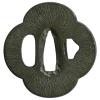The reality is that armour would only be worn when it was perceived that it would be required. The average samurai in the Edo period was an administrator, not a warrior, most would not personally own or require armour. instances where armour would be required were minimal at best outside of the very early and very late Edo, and generally related to policing. The armour did exist and was used, this is not in question and was likely worn in the ways depicted in the prints, but no where in your examples does it show that such armour would be carried or worn on a daily or even a regular basis. Like all armour of the period it would be stock piled either personally or collectively and pulled out and used when required.
Tatami armour was common because it was cheap and because it was and easy to store and cheap to maintain, the amount of protection given was adequate for the tasks it would be required for.
Tatami armour of higher quality, like the example posted by Ian is purely a reflection of taste of the person who commissioned it, in a time where it was quite unlikely that the armour would have to be used in combat by its owner, practical aspects of protection and usability generally gave way to the stylistic whims of the person commissioning it (there were of course many practical and serviceable armours produced during the Edo period, but there are just as many that are not). This is not to say that this particular example is impractical as armour but it would not need to be worn very often nor would it likely have to fulfill its defensive role.
Tom,




